Lawn Alternatives
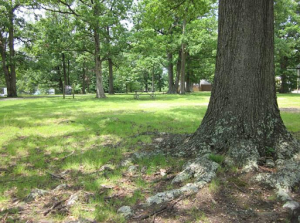
Upland oaks and poverty oatgrass (Danthonia spicata), parasol sedge (Carex umbellata), lichens, mosses and diminutive wildflowers in Arlington, Virginia. Photo by R.H. Simmons.
For many years, the American lawn has been viewed as a status symbol. Traditional lawns, described as a single warm season grass species like zoysia or bermuda, completely covering a yard space and maintained at three inches or shorter, are unfortunately often ecological wastelands that require excess water, nutrients, pesticides and maintenance. Traditional lawns also support few wildlife species. To help local wildlife, consider replacing non-native grass lawns with native alternatives. By selecting native plants suited for your site, you can reduce the time and supplies needed to maintain turf grass and can provide habitat for wildlife in the process.
This article and many of its associated photos are thanks to Rod Simmons, Natural Resource Manager and Plant Ecologist with the City of Alexandria.
Getting Started
1. Site Selection. The first step is always to select the site of interest. How do you use your current lawn? Are there any areas that don’t get much use that would be easy to replace with alternative plants? It is important to note that many of the recommendations below can sustain moderate amounts of foot traffic but may not be suitable to areas that get a lot of use. Consider selecting a small area to start with to perfect your replacement approach.
2. Assess Site Conditions. It is always best to plant for your site to decrease or eliminate the need for supplemental water and/or fertilizers. How wet or dry is the site? How long does water pool after a storm? What is the soil pH, and how much sun does the area typically receive? Is the soil relatively nutrient poor or is it rich? How much space do you have? Be sure to have the answers to these questions before selecting plants so you know which plants will work the best.
3. Clear Existing Vegetation. Once you have selected and assessed your site, you should clear the existing vegetation. Often, it takes two to four months to completely clear an area of turf grasses. Clearing vegetation can include repeat tilling, smothering and/or herbicide treatment. If using herbicides, be sure to only apply as directed and to choose herbicides suited for your site and needs. For example, some herbicides cannot be used near water and others are best for killing grasses but not flowers.
4. Select Plants. While existing vegetation is being removed and/or smothered, spend time researching plants that may work for both your site conditions and for your habitat goals. Consider if you would rather buy seeds, which are often cheaper but take more time to establish, or if you would rather invest in plugs. Seed suppliers can often assist with determining the amount of seed needed for particular areas, as well as the best way to plant seeds. Research local plant suppliers. For a list of suppliers, check out the Maryland Native Plant Society website. In addition to the nurseries on the Maryland Native Plant Society website, nurseries such as Chesapeake Valley Seed, Ernst Conservation Seed and Prairie Moon Nursery also provide seeds.
5. Plant! Most turf grass alternatives are best sown or planted in fall or spring. If planting plugs, be sure to pay attention to suggested spacing and spread guidelines. Consider adding mulch in between plugs until fully established. If planting seeds, pay attention to guidelines and make sure the soil is clump-free before spreading seed. Consider dragging a rake through the soil to remove potential clumps and to mix in seed. Roll soil to firmly press seeds into raked soil and mulch with weed-free straw and water.
6. Weed. Unfortunately, during the early stages of establishment, weeding is important to maximize the success of your new plantings. Consider hand pulling any weedy vegetation to allow your new plants to thrive. Once established, the time needed to weed and manage the area should be minimal.
Turf Grass Alternatives
Below are some turf grass alternatives that are native to Maryland and are often easy to find at native plant nurseries. All of the plants listed below do not require mowing, but some of the species can be occasionally mowed to achieve a shorter height.
Common Wood Sedge (Carex blanda)
This evergreen sedge produces attractive, dense tufts of foliage from short rhizomes. It grows well in part-sun conditions in moist to mesic soils that are alkaline. The foliage gets up to two feet tall and can be aggressive in bare soil conditions. It can tolerate moderate foot traffic. Plant plugs 1.5-2’ apart. Appalachian brown butterflies lay their eggs on the leaves and birds, such as woodcock, ruffed grouse and sparrows, eat the seeds.
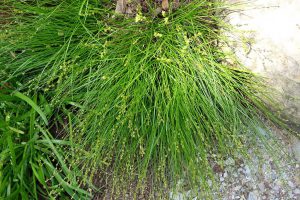
Eastern Star Sedge by Daderot – Own work, CC0
Eastern Star Sedge (Carex radiata)
Eastern star sedge has dainty star-shaped inflorescences (flowers) that rise above fine, clumped leaves. It grows best in mesic to moist soils in part sun to shade. It can grow 1-2’ in height. Plant plugs 1’ apart. It can tolerate moderate foot traffic. Songbirds and upland gamebirds enjoy the seeds.
Field Pussytoes (Antennaria neglecta)
Field pussytoes is a spreading perennial wildflower that forms rosettes of leaves. It thrives in full sun to part sun in dry, clay soils. It can also tolerate growing in rocky environments. When flowering, plants are around one foot tall and can spread up to a foot via runners. They can tolerate light foot traffic but cannot be mowed. Consider planting alone or adding in between clumps of grasses or sedges. Plant plugs 1’ apart. American painted lady butterflies feed on the foliage and small bees pollinate the flowers.
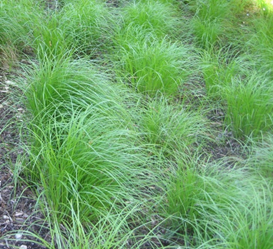
Pennsylvania sedge clumps at Scotts Arboretum by Susan Harris CC by 2.0
Pennsylvania Sedge (Carex pensylvanica)
Pennsylvania sedge is a semi-evergreen native sedge that thrives in part sun conditions. It can tolerate shade but becomes sparse in growth. This sedge performs best in dry, acidic soil and can spread in the right conditions. The clumps of leaves are around eight inches tall. This sedge is clump forming and can be mowed around three inches high. It can withstand moderate foot traffic as well. Plant plugs 1’ apart.
Poverty Oat Grass (Danthonia spicata)
This petite, cool season grass grows best in poor, dry soil in full sun to part-shade. It can even grow in rocky conditions but does not tolerate rich soils. Poverty oat grass grows in clumps but is usually pretty sparse. In the wild, it is often found under oaks. Consider adding spring beauty (Claytonia virginica) or bluets (Houstonia sp.) for a touch of color in between the patches. As it grows, the edges will curl, and it can tolerate occasional mowing and moderate foot traffic. This grass can sometimes be difficult to establish from seed, so give it time or consider purchasing plugs. Plant plugs 8-12” apart. Several species of skippers feed upon poverty oat grass.
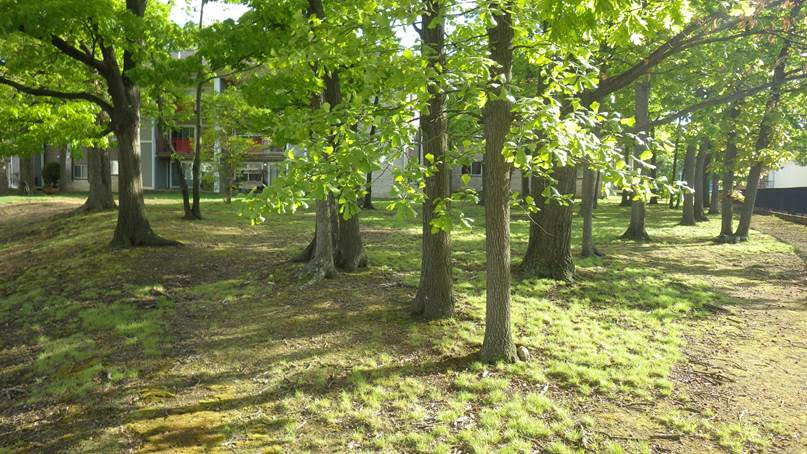
Native lawn of poverty oatgrass (Danthonia spicata), parasol sedge (Carex umbellata), lichens and mosses under mixed upland oaks in the City of Alexandria, Virginia. Photo by R.H. Simmons.
White-tinged Sedge (Carex albicans)
This sedge grows in dense, mounded tufts that rarely are higher than eight inches. It grows best in part to full shade and in moist to dry soils. It can tolerate light foot traffic and can be mowed a couple times per season. Consider adding lyre-leaved sage (Salvia lyrata) or bluets (Houstonia sp.) for a touch of color between the clumps. Plants can spread via rhizomes but are not aggressive. Plant plugs 12-18” apart.
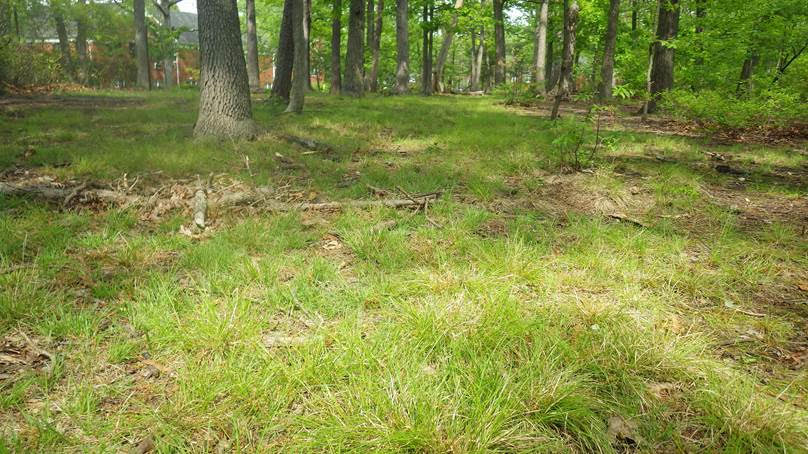
Extensive colony of Emmons’ Sedge (Carex albicans var. emmonsii) in Oak-Heath Forest in Alexandria, Virginia. Photo by R.H. Simmons.
For many native “lawns,” it will take 2-3 years for the plants to become fully established. During this time, maintenance may be needed to mow and remove weeds as your new plants grow to maturity. For more detailed information on how to install and maintain these areas, check out this article from The Habitat Network.
References:
Brown, J. and K. Brown. 2019. New Moon Nursery website. http://www.newmoonnursery.com/ Accessed May 28, 2019.
Hilty, J. 2019. Illinois Wildflowers website. https://www.illinoiswildflowers.info/ Accessed May 28, 2019.
Simmons, R. H. 2019. Personal communication.
Welcome to Summer!
It seems like spring has quickly blossomed into summer! We are now in peak bloom time for many local plant species, as well as peak activity for local wildlife.
In this issue of HabiChat, you can learn about a lovely group of perennial flowers known as mountain mints, as well as a common backyard snake – the eastern ratsnake. In addition, thanks to Rod Simmons, Natural Resource Manager and Plant Ecologist with the City of Alexandria, I have included a short article on alternatives to traditional lawn.
I am also excited to announce a new Common Snakes of Maryland Photo Guide which covers twelve of the most commonly seen snakes in the state. I also have been busy updating our Snakes of Maryland pages to reflect recent changes in taxonomy.
As summer ripens, check out some of our previous HabiChat articles on topics such as Xeriscaping, Minimizing Pesticide Impacts to Pollinators or Growing Your Own Seed. Don’t forget to add water to your landscapes as well! Finally, keep in mind that deer are currently giving birth. For questions regarding fawns, check out our Deer Fawn page.
Happy Habitats,
Kerry Wixted
Click here to have HabiChat—the quarterly backyard wildlife habitat newsletter from the Wild Acres program—delivered right to your inbox!
In this Issue
Habitat Tips: Lawn Alternatives
Native Animal Profile: Eastern Ratsnake
Native Plant Profile: Mountain Mint
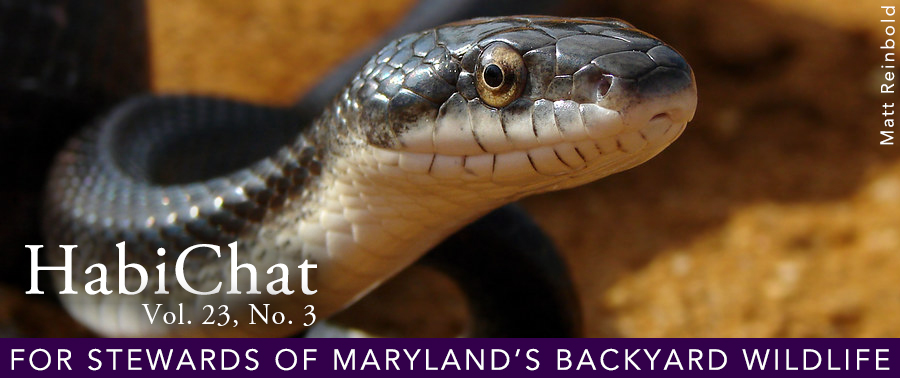

 1-888-373-7888
1-888-373-7888 233733
233733